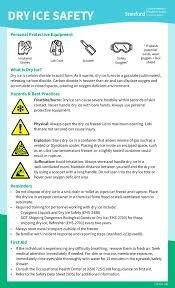Introduction
Dry ice safety, the solid form of carbon dioxide (CO₂), is widely used for its cooling and fog-producing properties. It plays a significant role in various applications, from preserving food to creating dramatic effects in theatrical productions. Despite its versatility, dry ice must be handled with care to ensure safety. This article provides essential guidelines for handling and using dry ice safely, covering everything from basic precautions to emergency measures.
What Is Dry Ice?
1. Understanding Dry Ice
Dry ice is the solid form of carbon dioxide, a gas that is naturally present in the atmosphere. Unlike regular ice, which is made of water, dry ice sublimates directly from a solid to a gas at temperatures above -78.5°C (-109.3°F). This sublimation process creates a fog-like effect that is often used for visual effects and cooling purposes.
2. Safety Considerations
While dry ice is useful and visually appealing, it poses specific safety risks due to its extremely low temperature and gaseous sublimation. Proper handling and usage are crucial to avoid accidents and injuries.
Essential Safety Guidelines
1. Proper Handling
- Wear Protective Gear: Always use insulated gloves or tongs when handling dry ice. Direct contact with the skin can cause severe frostbite or burns due to its extremely low temperature.
- Avoid Direct Contact: Never touch dry ice with bare hands or allow it to come into direct contact with your skin. The risk of frostbite is high.
2. Storage and Usage
- Ventilation: Dry ice sublimates into CO₂ gas, which can displace oxygen in enclosed spaces. Ensure that the area where dry ice is used or stored is well-ventilated to prevent CO₂ buildup, which can lead to respiratory issues or suffocation.
- Storage Containers: Store dry ice in an insulated container that allows gas to escape. Do not seal dry ice in a completely airtight container, as the pressure from sublimated gas can cause the container to burst.
3. Transportation
- Use Proper Containers: When transporting dry ice, use containers that are specifically designed for this purpose. These containers should be well-ventilated to allow gas to escape and prevent pressure buildup.
- Avoid Sealed Containers: Never transport dry ice in sealed or airtight containers, as the pressure from the sublimated gas can cause explosions.
4. Disposal
- Let It Sublimate: The safest way to dispose of dry ice is to let it sublimate in a well-ventilated area. Do not dispose of dry ice in sinks, toilets, or other plumbing fixtures, as it can cause damage or blockages.
- Follow Local Guidelines: Check local regulations or guidelines for disposing of dry ice, especially if you have large quantities to dispose of.
Emergency Procedures
1. First Aid for Frostbite
- Seek Medical Attention: If you or someone else comes into direct contact with dry ice and experiences frostbite, seek medical attention immediately.
- Avoid Rubbing the Affected Area: Gently warm the affected area with warm (not hot) water and avoid rubbing it, as this can cause further damage.
2. In Case of CO₂ Buildup
- Move to Fresh Air: If you experience dizziness, shortness of breath, or other symptoms of CO₂ exposure, move to a well-ventilated area or fresh air immediately.
- Seek Medical Help: If symptoms persist or worsen, seek medical attention promptly.
Best Practices for Safe Use
1. Educate and Train
- Inform Others: Ensure that everyone involved in handling dry ice is aware of the safety guidelines and procedures. Education is key to preventing accidents and injuries.
- Provide Training: If you frequently use dry ice in your operations, consider providing formal training for staff or participants on safe handling practices.
2. Regular Inspections
- Check Containers: Regularly inspect storage and transportation containers for signs of wear or damage. Replace or repair containers as needed to ensure safety.
- Monitor Conditions: Keep an eye on the conditions where dry ice is stored or used to ensure proper ventilation and safe handling practices.
Conclusion
Dry ice is a valuable tool for many applications, but its use requires careful handling and adherence to safety guidelines. By following these essential guidelines for handling and usage, you can ensure a safe and effective experience with dry ice. Proper protective measures, ventilation, and storage practices are crucial to avoiding accidents and ensuring the safety of everyone involved. Whether you’re using dry ice for scientific experiments, theatrical effects, or food preservation, understanding and applying these safety principles will help you enjoy its benefits while minimizing risks.


